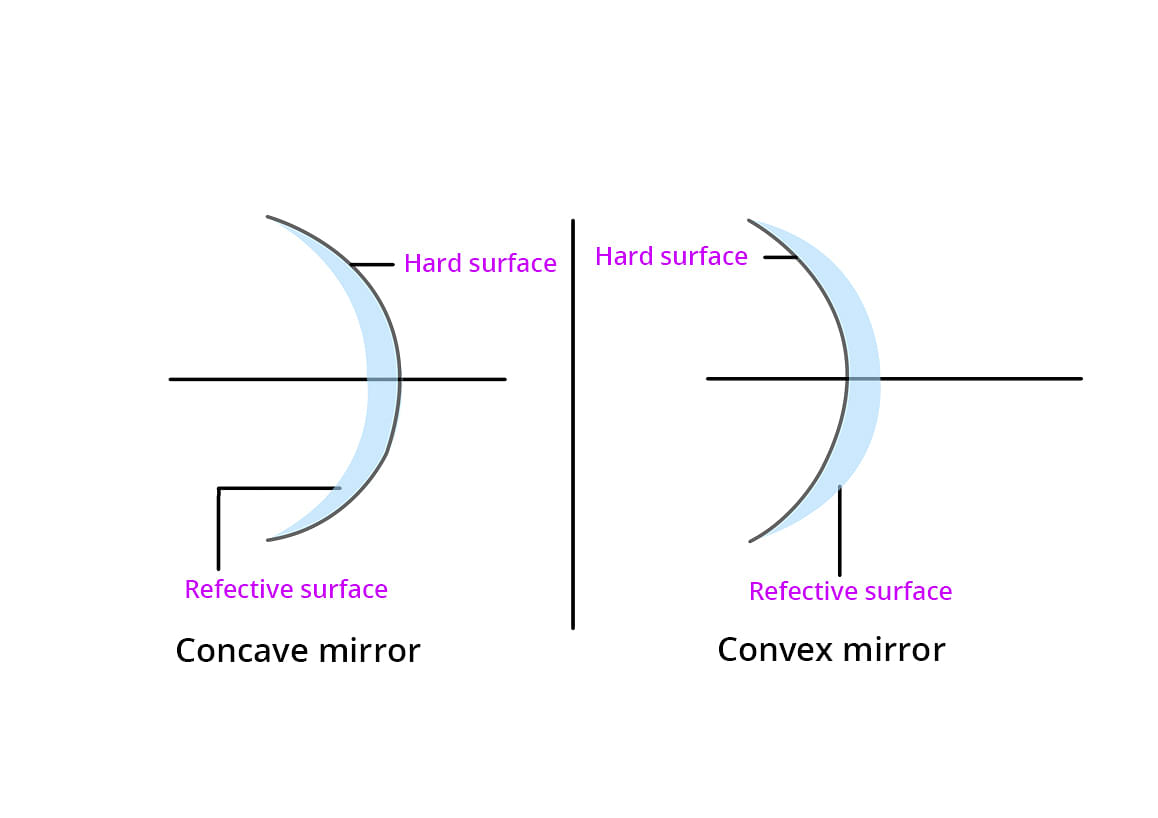Name the type of mirror used in the following situations. - Headlights of a car
- Side/rear-view mirror of a vehicle
- Solar furnace
Support your answer with reason.
- Headlights of a car
- Side/rear-view mirror of a vehicle
- Solar furnace
Support your answer with reason.
Solution and Explanation
(a) Concave mirror: Concave mirror is used in the headlights of a car. This is because concave mirrors can produce powerful parallel beam of light when the light source is placed at their principal focus.
(b) Convex mirror: Convex mirror is used in side/rear view mirror of a vehicle. Convex mirrors give a virtual, erect, and diminished image of the objects placed in front of it. Because of this, they have a wide field of view. It enables the driver to see most of the traffic behind him/her.
(c) Concave mirrors: Concave mirrors are convergent mirrors. That is why they are used to construct solar furnaces. Concave mirrors converge the light incident on them at a single point known as principal focus. Hence, they can be used to produce a large amount of heat at that point.
Top Questions on Spherical Mirrors
- A concave mirror produces an image of an object such that the distance between the object and image is 20 cm. If the magnification of the image is \( -3 \), then the magnitude of the radius of curvature of the mirror is:
- JEE Main - 2025
- Physics
- Spherical Mirrors
- (ii) An object at a distance of 16 cm from a spherical mirror forms a virtual image at a distance of 12 cm behind the mirror. Determine the magnification of the image and type of the mirror.
- UP Board X - 2025
- Science
- Spherical Mirrors
- Image of an object formed by a concave mirror is real and of the size of the object. The object is placed -
- UP Board X - 2025
- Science
- Spherical Mirrors
- With the help of a suitable ray diagram, derive the formula \( \frac{1}{v} + \frac{1}{u} = \frac{1}{f} \) for a concave mirror.
- UP Board XII - 2025
- Physics
- Spherical Mirrors
- The length of the image formed by a concave mirror:
- UP Board XII - 2025
- Physics
- Spherical Mirrors
Questions Asked in CBSE X exam
- Matilda’s character embodies the journey of change or progression throughout the story, encapsulating the transformations she endured as a consequence of her experiences, trials, and engagements with other characters.
In the light of the above information, trace the transformation seen in Matilda’s character in the story.
(The Necklace) - Read the given details of a computer.
electronic device that can store and process information makes life easy and simple physical description — monitor, keyboard, CPU and mouse computer technology used in all fields — education, medicine, commerce, entertainment Analyze the details and write an analytical paragraph in about 120 words about the description and role of computers in today’s world.- CBSE Class X - 2025
- Writing Skills
- Explain with examples the significance of the Non-Cooperation Movement in the Indian national movement.
- CBSE Class X - 2025
- Nationalism in India
- Nidhi received simple interest of ₹1,200 when she invested ₹x at 6% per annum and ₹y at 5% per annum for 1 year. Had she invested ₹x at 3% per annum and ₹y at 8% per annum for that year, she would have received simple interest of ₹1,260.Find the values of x and y.
- CBSE Class X - 2025
- Linear Equations
- Describe any three features of the multiparty system.
- CBSE Class X - 2025
- Political Parties
Concepts Used:
Spherical Mirrors
A spherical mirror is a mirror which has been cut out of a spherical surface.
There are two kinds of spherical mirrors:
- Convex Mirror
- Concave Mirror

Concave Mirror
Concave mirrors are also called converging mirrors, because in these types of mirrors, light rays converge at a point after impact and reflect back from the reflective surface of the mirror.
Convex Mirror
The convex mirror has a reflective surface that is curved outward. Regardless of the distance between the subject and the mirrors, these mirrors are "always" virtual, upright and reduced.